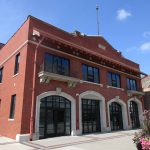
Art Deco is one of my favorite design styles. It’s the grandeur of the Empire State Building, the stylized fashion drawings of Erté (trust me, give that a Google), and the sleek geometric lines of 1920s and 1930s travel posters. It is the architectural backdrop in my head to Batman’s broody Gotham City and the sumptuous crime scenes of Agatha Christie novels.
Art Deco buildings are in short supply on my side of Iowa, so I traveled to Omaha to view the splendor of the 1931 Union Station, now home to the Durham Museum. You need to see this Art Deco train station with your own eyes!
Dripping with Art Deco Design

Union Station opened in 1931 after two years of construction. The 124,000-square-foot building cost $3.5 million (1). Its design was intended to be grandiose, despite the economy still quivering from the stock market crash.
“We have tried to express the distinctive character of the railroad: strength, power, masculinity,” said the architect Gilbert Stanley Underwood (2), who was also responsible for the U.S. State Department Building, San Francisco Mint, and a number of iconic state park lodges.

Because Union Station’s “ultra-modern appearance was a major departure from previous railroad station designs,” the structure was recognized by the Department of the Interior as a National Historic Landmark in 2016 (3). It is one of 2,600 sites around the country that have been designated “as exceptional because of their abilities to illustrate U.S. heritage” (4).
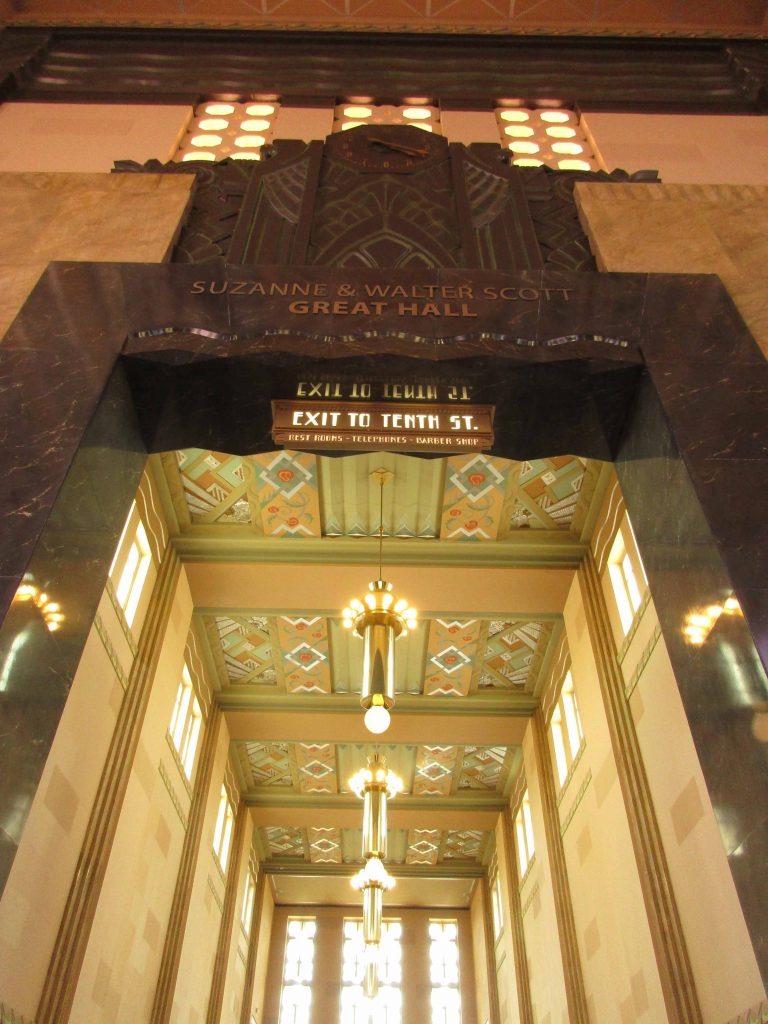
The building is considered “one of the most distinctive and complete examples of Art Deco architecture in the nation. The station outstandingly expresses the style’s innovative and diverse surface ornamentation inspired by the machine age” (3).
The thing that made my jaw drop was the 60-foot-high ceilings. You cannot help stopping dead in your tracks and gapping upward. Or is that just me? Anyways …
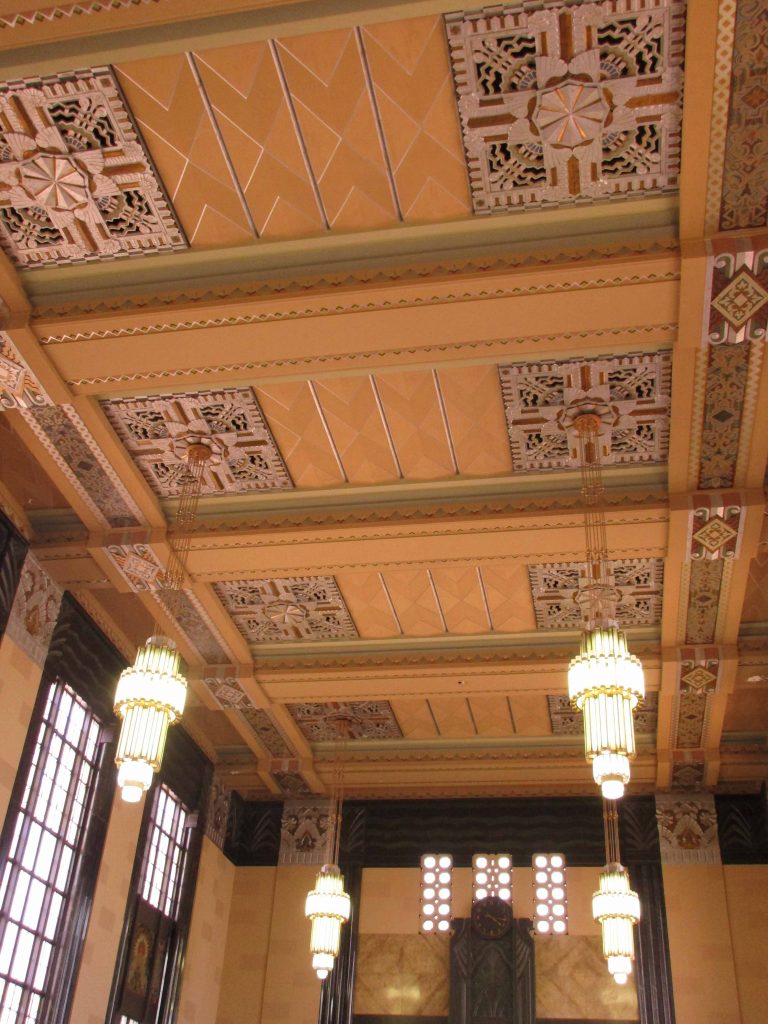

Art Deco isn’t just geometric shapes – it’s a series of bold graphic lines that creates a distinct and decorative pattern. It commands your attention and demands to be appreciated.
 Did I lay down on a bench to get this shot? I absolutely did.
Did I lay down on a bench to get this shot? I absolutely did.
And then I stayed there and admired the embellishments.

Fun fact – every square in the ceiling grid is actually a vent! Isn’t that the most beautiful way to deliver air conditioning? Vents are also hidden in the base of the benches to keep passengers comfortable.
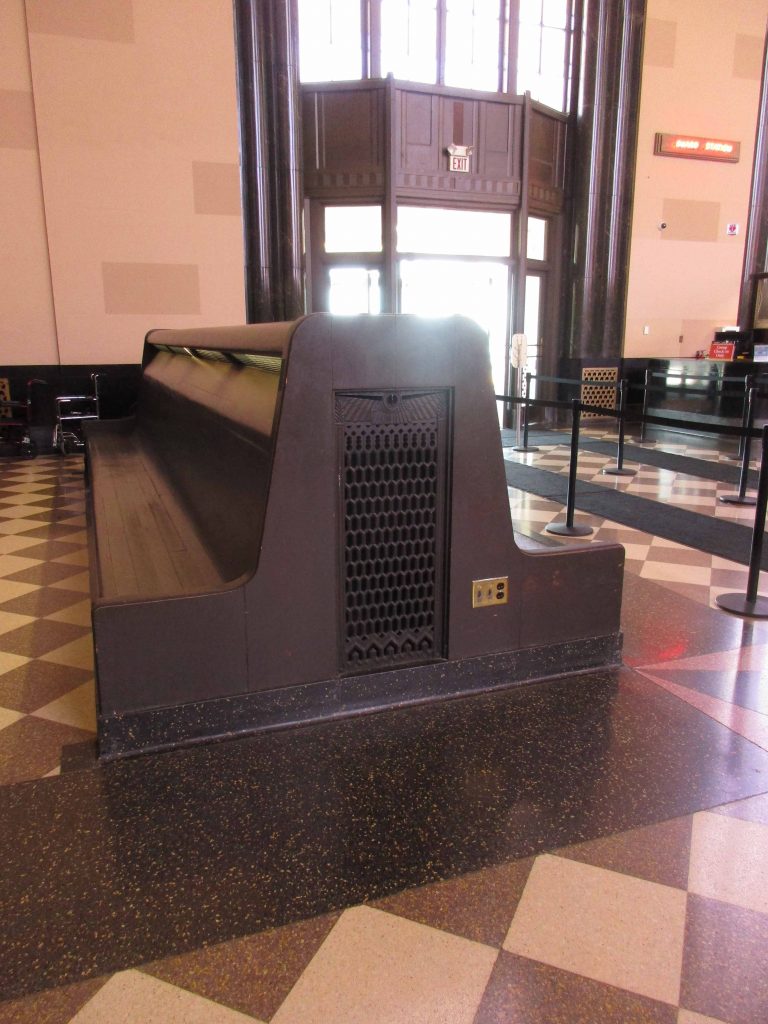
Another Art Deco element is the terrazzo flooring with a large medallion in the center of the main hall. Stylized sunbursts, compasses, and fan are all popular motifs in Art Deco. Terrazzo was also used extensively in this era because it is extremely resilient. It’s commonly seen in public buildings like courthouses, hospital corridors, and hotel lobbies.

Stroll Through The Past
Union Station was in use through 1971 when the last train left in May (5). Thankfully, Union Pacific gifted the building to the city of Omaha just two years later. It has been a museum since 1975, originally celebrating western expansion and currently focused on the history of Omaha and the surrounding region.

Personal plug – the Durham Museum is an affiliate of the Smithsonian Institution and has a wealth of displays for kids and adults alike. You could spend hours here and not cover everything. At $11 for admissions, it’s totally affordable too.
 Love the neon lettering!
Love the neon lettering!
One way to experience the history of the train station is to order a treat at the working Soda Fountain. My hometown had a drug store that still made phosphates (a type of flavored pop) when I was growing up – this brought back fun memories.

Past the Soda Fountain is what was a house restaurant. Can you imagine sitting down to grab a bite to eat here while waiting for your train to arrive? This outclasses even the nicest restaurants in modern airports.
“At its peak, 64 passenger trains and some 10,000 passengers utilized the facility every day. The station originally boasted thirteen sets of tracks located to the south of the building and served the Union Pacific, Rock Island, Missouri Pacific, Milwaukee, Wabash, Great Western, Illinois Central, and North Western Railroads. Combining its efforts with the Burlington Depot made Omaha the fourth largest railroad center in the United States” (1).


Other amenities included a taxi stand, barbershop, ladies lounge, and telegraph and telephone room. Everything about Union Station’s design was intended to leave passengers with the desire to travel through Omaha again.
“The Hall features a ceiling of sculptured plaster, with painted gold and silver leaf trim, ten cathedral-like plate glass windows, a patterned terrazzo floor, columnettes of blue Belgian marble, and a wainscoting of black Belgian marble. Six immense chandeliers, 13 feet tall, five feet in diameter, and suspended 20 feet from the ceiling, light the Great Hall” (1).
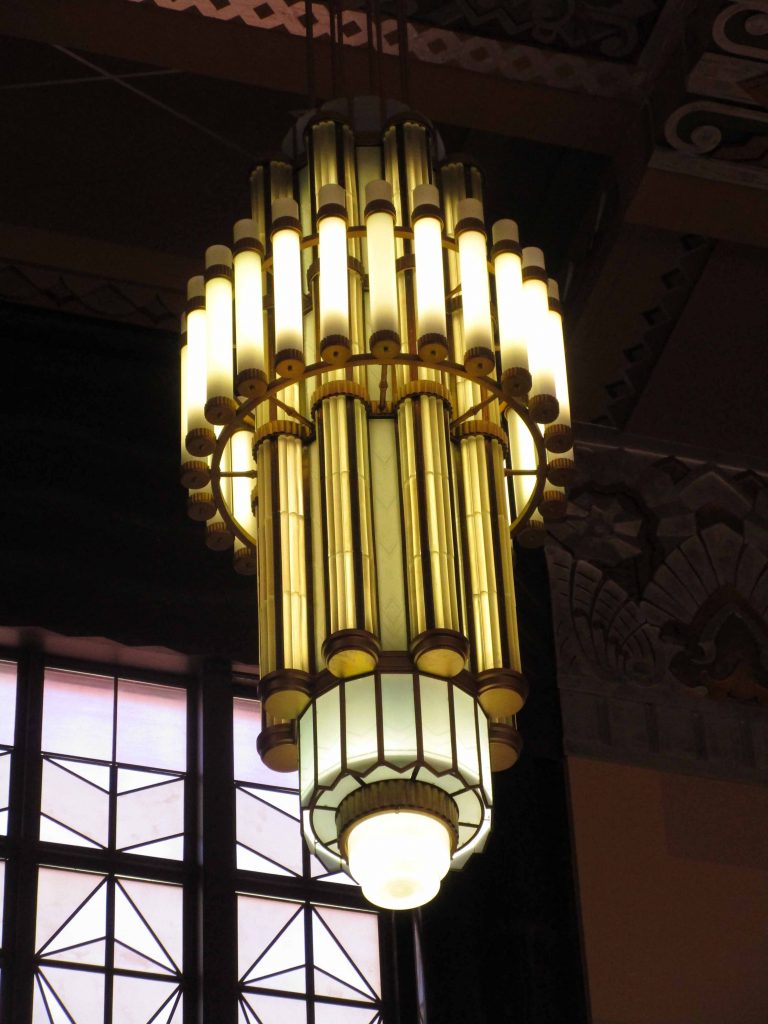 Curious how you change the light bulbs? There is a pulley system that lowers the chandeliers down.
Curious how you change the light bulbs? There is a pulley system that lowers the chandeliers down.
No climbing on ladders to reach these!
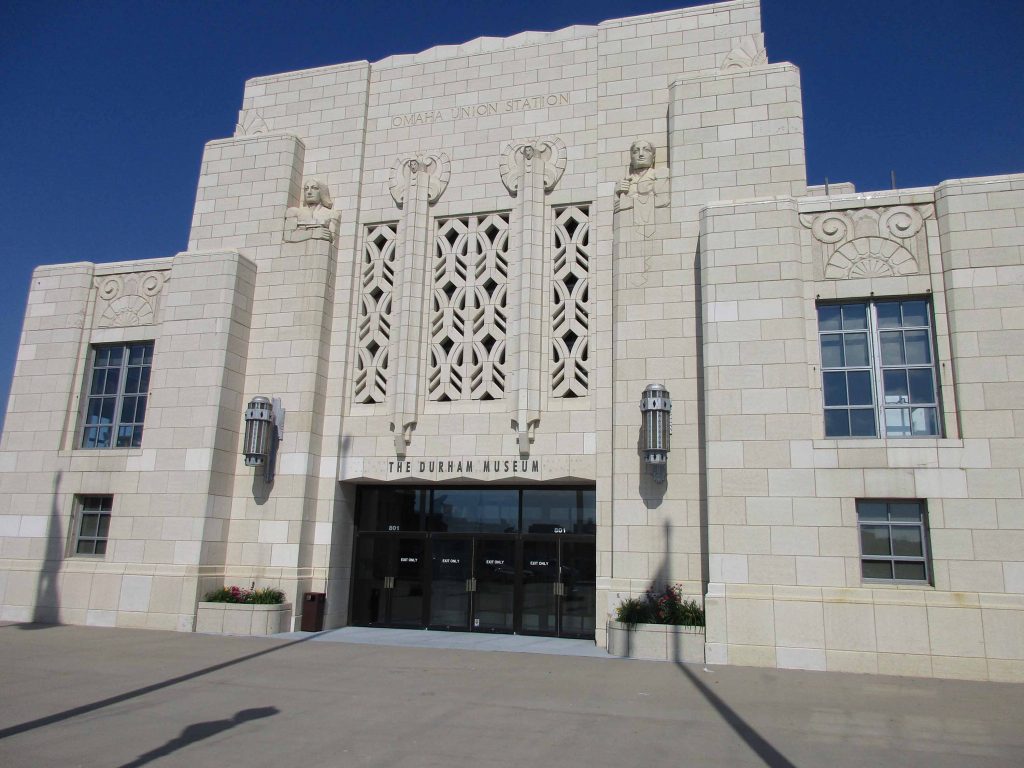
Union Station’s significance to downtown Omaha is undisputed. It is a contributing structure to the Omaha Rail and Commerce Historic District that encompasses several city blocks that owe their existence to the railroad (6). The building’s creamy glazed terra cotta is a stark contrast to the predominately red brick buildings that populate this area.
The city is currently investing $2.7 million dollars into “replacing all of the building’s mortar joints, re-sealing the perimeters of windows and doors, and refinishing the terra cotta facade with protective glaze,” according to the Omaha World-Herald (7).

Always adding to my architecture vocabulary, I learned this style of facade sculpture is called a herm. These exterior statues only show the torso and head (8), unlike a full body statute common to a gothic cathedral. Union Station has a stylized herm flanking either side of the main entrances. Look close and each one is a different type of railroad worker (one has an oil can, one has a wrench, and so forth).
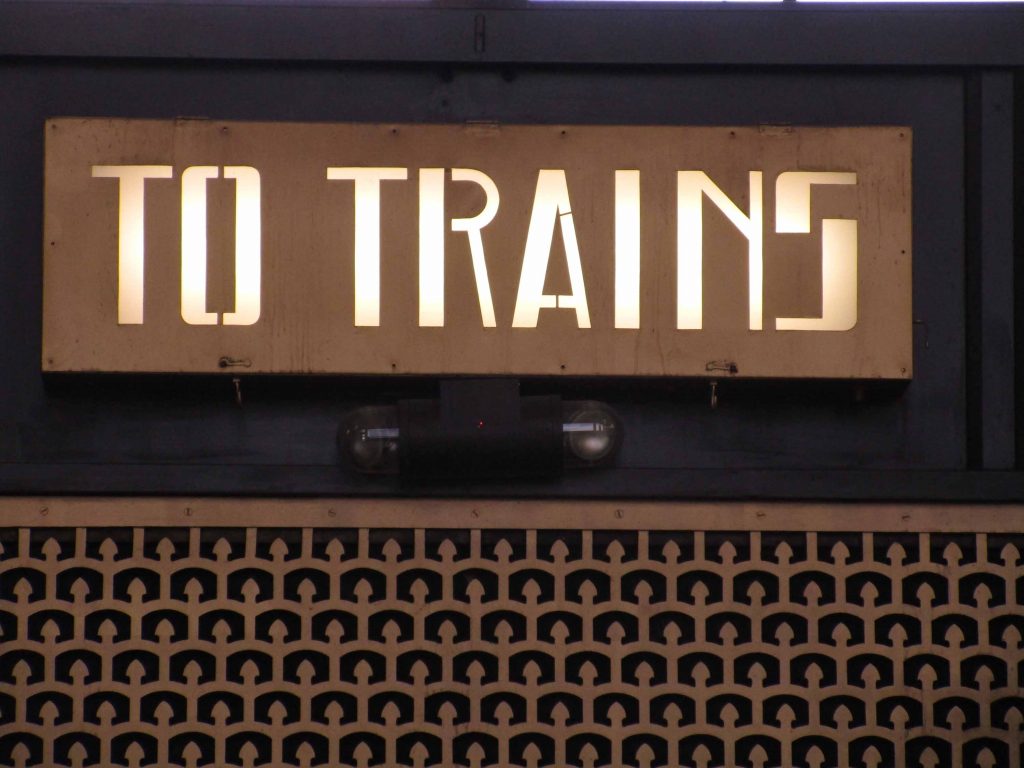
I can’t wait to explore more of our country’s train stations! I’ve had the pleasure of visiting Union Station in St. Louis on foot and traveling through Union Station in Washington, D.C. by actual rail. What other stations and depots should I add to my must-see list?
Enjoy this blog and own a historic building? I can research the origin and evolution of your property and write an engaging article for your website and social media. Contact me for more details!
References
- https://durhammuseum.org/our-museum/history-of-union-station/
- https://en.wikipedia.org/wiki/Union_Station_(Omaha)
- https://www.doi.gov/pressreleases/interior-department-announces-24-new-national-historic-landmarks
- https://www.nps.gov/orgs/1582/index.htm
- https://durhammuseum.org/our-museum/historic-timeline/
- https://landmark.cityofomaha.org/article/4127-omaha-rail-and-commerce-historic-district
- https://www.omaha.com/living/durham-museum-plans-million-project-to-repair-union-station-exterior/article_393f3e64-7158-11e7-81d6-2bd9157b09e7.html
- https://www.nps.gov/articles/sculptural-herms-omaha-union-station-and-art-deco.htm


